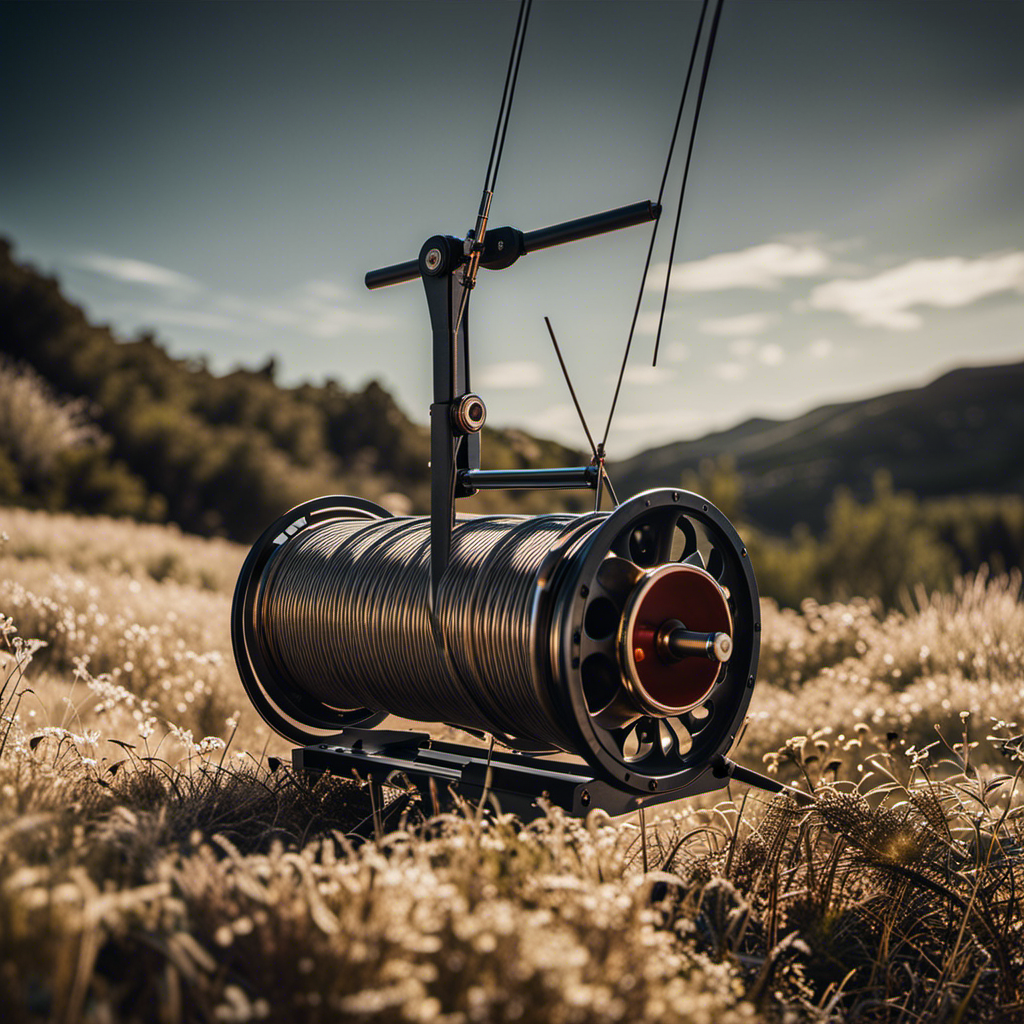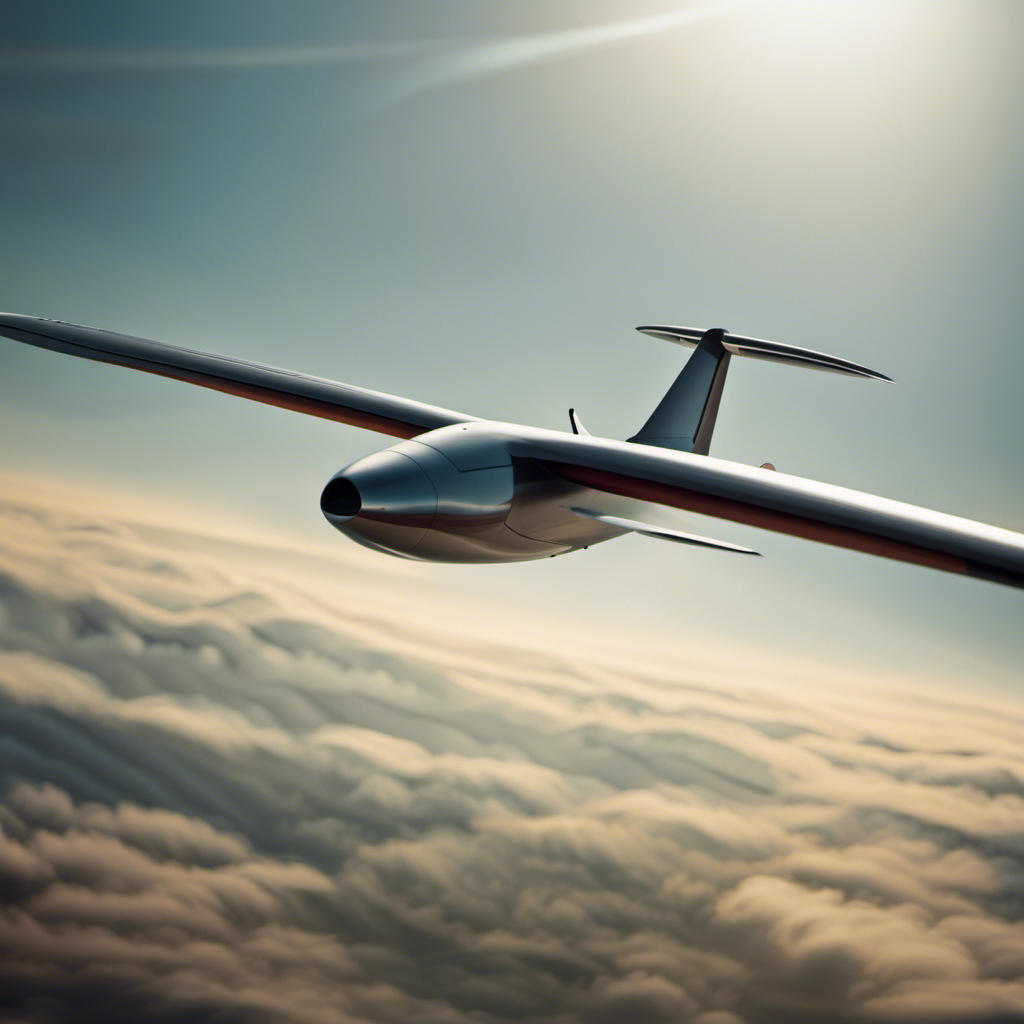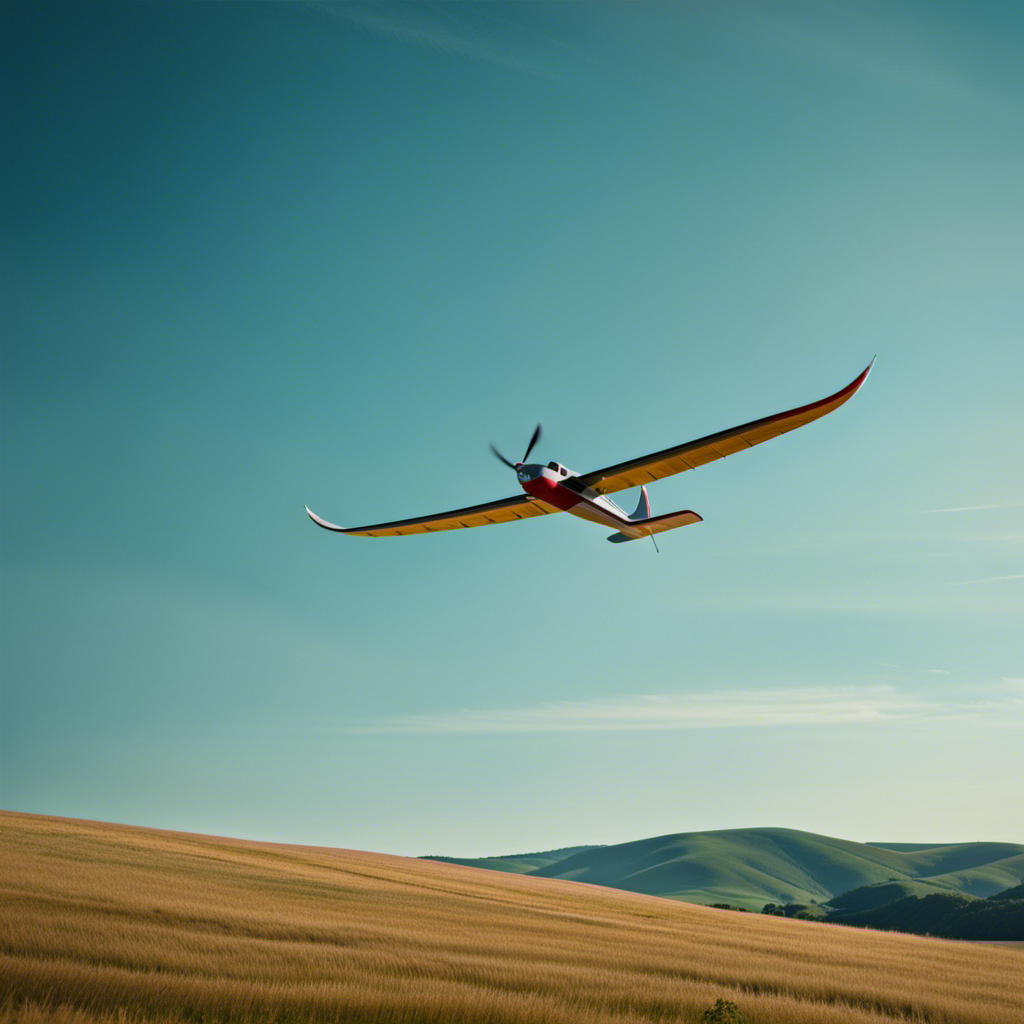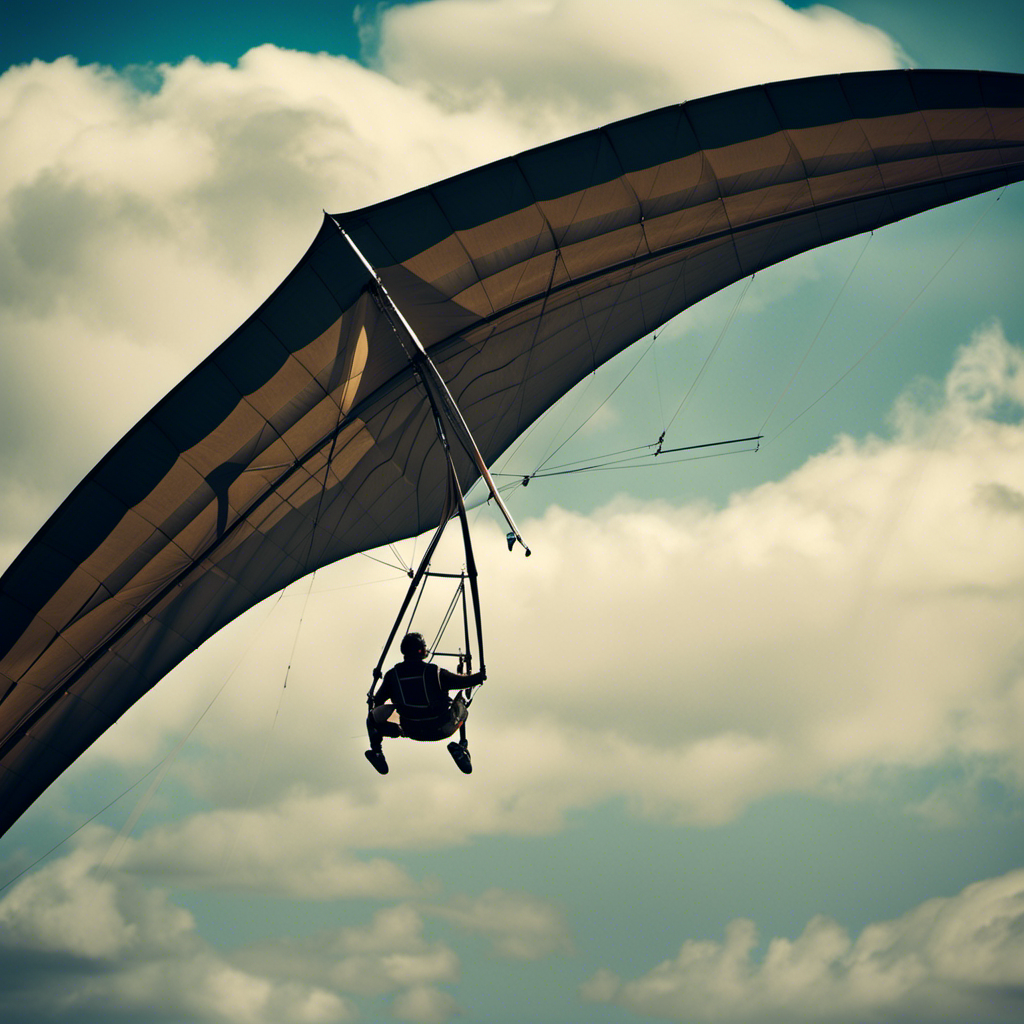Have you ever wondered how a model glider is able to gracefully and precisely glide through the air? Let me explain – it all starts with a winch system.
In this article, I will take you on a journey into the inner workings of a model glider winch, revealing the secrets behind its power and efficiency. Get ready to delve into the technical intricacies and discover the precise techniques that make this marvel of engineering possible.
So, buckle up and prepare to be amazed!
Key Takeaways
- Model gliders are launched using a winch system that combines mechanical and electrical components.
- Proper winch tension is crucial for a smooth and controlled launch, ensuring optimal performance and safety.
- Regular maintenance and inspection of the winch system are necessary to prevent malfunctions and ensure safe operation.
- Troubleshooting techniques can be used to address common issues such as line tangles and winch malfunctions, ensuring the smooth operation of the winch system.
The Basics of Model Gliders
To understand the basics of model gliders, you’ll need to know how a winch works.
Model gliders are aircraft that are built on a smaller scale and are designed to be launched into the air using a winch system.
The construction of a model glider involves carefully selecting lightweight materials such as balsa wood and carbon fiber to ensure optimal performance.
Flying techniques play a crucial role in controlling the glider’s flight path and maximizing its efficiency.
By understanding the different aspects of model glider construction and mastering flying techniques, pilots can achieve longer flight times and more precise maneuvers.
Now, let’s delve into understanding the winch system and how it enables the launch of model gliders into the sky.
Understanding the Winch System
Understanding how the winch system operates is crucial for controlling the model glider during flight. The winch mechanics involve a combination of mechanical and electrical components that work together to generate the necessary power to launch the glider into the air. To calculate the winch power, several factors must be taken into consideration.
These factors include the weight of the glider, the desired launch speed, and the efficiency of the winch system. By using a simple formula, the power required can be determined. It is important to ensure that the winch motor and gearbox are capable of delivering the necessary power to achieve a successful launch.
Once the winch power has been calculated, adjustments can be made to optimize the system for maximum performance. With a thorough understanding of the winch mechanics and proper power calculations, the model glider can be launched with precision and control.
Transitioning into the subsequent section about ‘launching a model glider with a winch,’ it is important to consider the various techniques and strategies for achieving a successful launch.
Launching a Model Glider with a Winch
When launching a model glider with a winch, you should carefully consider the techniques and strategies to achieve a successful launch.
Here are some advantages and tips for improving winch launching techniques:
-
The winch provides a powerful and consistent launch, allowing the model glider to gain altitude quickly and efficiently.
-
Properly adjusting the winch tension is crucial to ensure a smooth launch. Too much tension can lead to a sudden and jerky ascent, while too little tension may result in a weak launch.
-
Maintaining a steady and controlled speed during the launch is important. Too fast or too slow of a launch speed can affect the glider’s performance.
-
Timing the release of the glider is essential for a successful launch. Releasing too early or too late can result in a loss of altitude or even a crash.
-
Practicing and refining your launching technique will help you achieve better launches consistently.
Understanding the role of tension in the winch system is crucial for maximizing the efficiency and effectiveness of the launch.
The Role of Tension in the Winch System
Maintaining the proper tension in the winch system is essential for a successful launch. The tension in the winch system plays a crucial role in ensuring optimal performance and safety of the model glider.
Too much tension can cause excessive stress on the system, leading to potential damage or even failure during launch. On the other hand, insufficient tension can result in a weak launch, limiting the glider’s altitude and distance.
To achieve the right tension, it is important to consider several factors such as the weight of the glider, wind conditions, and the desired launch speed. By adjusting the tension accordingly, the winch system can deliver the necessary power to catapult the glider into the sky with precision and efficiency.
Now, let’s delve into the safety measures and considerations to ensure a successful and secure launch.
Safety Measures and Considerations
When it comes to using a winch system, safety is of paramount importance.
In order to ensure the safe operation of the winch, it is crucial to adhere to specific guidelines.
Additionally, proper maintenance and inspection are essential to keep the winch in optimal working condition and prevent any potential malfunctions.
Safety guidelines for using a winch system
To ensure your safety while using a winch system, be sure to follow these guidelines.
First and foremost, always wear appropriate safety gear, including gloves and eye protection.
Before operating the winch, inspect the equipment for any signs of damage or wear. Ensure that the winch is securely anchored to a stable structure.
Use the winch only for its intended purpose and within its specified weight capacity. Always keep a safe distance from the winch cable during operation.
Finally, never leave the winch unattended while it is in use. By adhering to these safety precautions and using the winch system properly, you can minimize the risk of accidents or injuries.
Moving on to proper maintenance and inspection, it is important to regularly check the winch for any signs of wear or damage.
Proper maintenance and inspection
Regularly checking the winch for wear or damage is crucial to ensuring its proper function. Maintenance best practices and regular inspections are essential for the safe and efficient operation of a model glider winch. Here are some key points to consider:
- Inspect the winch drum and cable for any signs of fraying or damage.
- Check the winch frame for any cracks or loose bolts.
- Lubricate the winch components regularly to reduce friction and extend their lifespan.
- Clean the winch drum and cable to remove any dirt or debris that could affect performance.
- Test the winch’s pulling power and speed to ensure it meets the required specifications.
By following these maintenance best practices and conducting regular inspections, you can identify and address any potential issues before they lead to accidents or equipment failure.
Taking these precautions will help create a safe environment for glider launches and prevent accidents.
Precautions to prevent accidents
After ensuring the proper maintenance and inspection of my model glider winch, it is crucial to take the necessary precautions to prevent accidents during operation. Safety should always be a top priority.
To minimize the risk of accidents, I make sure to follow a few key safety precautions. First, I always wear protective gear such as safety goggles and gloves to protect myself from any potential hazards. Additionally, I ensure that the winch is securely anchored to the ground before launching the glider. This prevents any unexpected movement or tipping during the launch. Furthermore, I maintain a safe distance from the winch and keep bystanders away from the launch area.
By implementing these safety measures, I can enjoy the thrill of flying my model glider while minimizing the risk of accidents.
Transitioning into the subsequent section on common challenges and troubleshooting, it is important to be aware of potential issues that may arise during operation.
Common Challenges and Troubleshooting
When it comes to operating a model glider winch, there are several common challenges that may arise.
One of these challenges is dealing with line tangles, which can occur when the lines become twisted or caught on something.
Another challenge is addressing winch malfunctions, such as a motor that won’t start or a drum that is not winding properly.
Fortunately, there are tips and techniques for troubleshooting these common issues, which can help ensure smooth and successful glider launches.
Dealing with line tangles
To avoid line tangles, make sure you’re carefully winding up the line after each flight. Dealing with line snags and untangling line knots can be frustrating, but with the right technique, it can be easily resolved.
Here’s a step-by-step guide to help you tackle this issue:
-
Assess the situation: Identify where the line is tangled or snagged. Is it a simple knot or a more complex tangle?
-
Gently untangle the line: Use your fingers to carefully loosen any knots or tangles. Avoid pulling forcefully, as this may worsen the situation.
-
Follow the path: Trace the line back to the winch drum, checking for any twists or loops that may have caused the tangle. Straighten out any areas of concern.
By following these steps, you can effectively address line tangles and ensure smooth and trouble-free flights.
Now, let’s explore how to handle winch malfunctions, which are another common challenge in model glider flying.
Addressing winch malfunctions
Don’t worry if the winch malfunctions; there are a few troubleshooting techniques that can help resolve the issue.
When it comes to advanced troubleshooting, preventing equipment failure is key. One common problem with winches is a failure to release or wind in the line properly. Start by checking the winch drum for any debris or tangles that could be obstructing the line.
Next, inspect the winch motor and gears to ensure they are functioning correctly. If the winch still does not work, it may be a problem with the electrical connections or the controller. Check the wiring and connections for any loose or damaged parts.
By following these troubleshooting techniques, you can quickly identify and address winch malfunctions, ensuring a smooth operation for your model glider.
Now, let’s move on to some tips for troubleshooting common issues.
Tips for troubleshooting common issues
After understanding the common malfunctions that can occur with a model glider winch, it is crucial to know how to troubleshoot and fix these issues.
Troubleshooting line tension is essential for ensuring a smooth launch. If the line tension is too loose, the glider may fail to gain enough altitude. Conversely, if the tension is too tight, it can put excessive strain on the winch and lead to potential damage. To troubleshoot line tension, one should inspect the winch drum for any signs of wear or damage and adjust the tension accordingly.
Additionally, fixing winch motor issues is vital for maintaining optimal performance. If the winch motor fails to start or operates inconsistently, checking the electrical connections, brushes, and armature for any faults can help identify the problem.
By addressing these common winch malfunctions, you can ensure a successful launch every time.
Transitioning into the subsequent section on advanced techniques for model glider winching, let’s explore further ways to optimize your winching experience.
Advanced Techniques for Model Glider Winching
When it comes to advanced launching techniques for model glider winching, there are several key strategies that can greatly improve performance.
One of these techniques involves adjusting the angle of the winch drum to optimize the launch trajectory.
Additionally, utilizing winch systems for competitions requires precise timing and coordination between the winch operator and the pilot to ensure smooth and efficient launches.
Advanced launching techniques
To achieve higher launch altitudes, you can try using advanced launching techniques with a model glider winch. These techniques involve optimizing launch angles to maximize the energy transfer from the winch to the glider. Here are three key techniques to consider:
-
Adjusting the winch tension: By increasing the tension on the winch line, you can generate more force to propel the glider upwards. However, it is important to find the right balance, as excessive tension can cause the glider to lose control.
-
Launching at the optimal angle: The launch angle plays a crucial role in determining the glider’s altitude. By launching at a slightly upward angle, you can take advantage of the winch’s power and achieve a higher launch altitude.
-
Timing the release: Releasing the glider at the right moment is essential for a successful launch. Timing it too early or too late can result in a less efficient transfer of energy.
By mastering these advanced winching techniques and optimizing launch angles, you can significantly improve your glider’s performance.
Now, let’s delve into the use of winch systems for competitions.
Transitioning from advanced launching techniques, we can now explore the use of winch systems for competitions.
Using winch systems for competitions
After exploring advanced launching techniques, I am eager to delve into the exciting world of using winch systems for competitions.
In these high-stakes events, competition strategies play a vital role in achieving success. One key aspect is modifying the winch system to maximize performance. By fine-tuning the winch’s power output and torque, we can optimize the launch speed and trajectory of the glider. Additionally, reducing the weight of the winch structure and incorporating high-strength materials can enhance its durability and efficiency. These modifications allow us to gain a competitive edge, enabling us to reach greater heights and cover longer distances.
Now, let’s transition to the subsequent section where we will discuss valuable tips for achieving maximum altitude without compromising safety or stability.
Tips for achieving maximum altitude
If you want to achieve maximum altitude in competitions, it’s important to focus on optimizing your launch speed and trajectory.
Achieving speed is crucial because it determines how quickly your glider can climb to its peak altitude. To increase speed, you can make adjustments to your winch system’s power output and rope length. A higher power output and shorter rope length can provide a stronger initial pull, propelling your glider forward with greater force.
Optimizing launch angle is equally important. By adjusting the angle at which your glider is released, you can ensure that it ascends at the most efficient trajectory. A steeper launch angle can result in a quicker climb, while a shallower angle can provide a longer glide.
By carefully considering both speed and launch angle, you can maximize your glider’s altitude potential in competitions.
Transitioning into the next section, choosing the right winch system plays a crucial role in achieving these goals.
Choosing the Right Winch System
When selecting the right winch system for your model glider, consider factors such as power, speed, and durability.
-
Power: Choose a winch system with sufficient power to launch your glider to the desired altitude. The power of a winch system is determined by the motor and battery capacity. Higher power means greater efficiency and better performance.
-
Speed: Look for a winch system that offers variable speed control. This allows you to adjust the launch speed based on wind conditions and the weight of your glider. Having control over the launch speed increases the efficiency and accuracy of your launches.
-
Durability: Consider the quality and durability of the winch system components. Look for materials that can withstand the stress of repeated launches and landings. Components like the drum, cable, and gears should be made from strong and durable materials to ensure long-lasting performance.
Considering these factors will help you choose a winch system that offers optimal efficiency and performance for your model glider.
Now, let’s move on to discussing the maintenance and care for winch systems.
Maintenance and Care for Winch Systems
After carefully selecting the right model glider winch system, it is crucial to ensure its longevity and optimal performance through regular maintenance and care. By following a few maintenance tips and troubleshooting techniques, you can keep your winch system in top shape.
Firstly, it is important to inspect the winch drum, cable, and pulley system for any signs of wear or damage. Lubricating the moving parts regularly will minimize friction and ensure smooth operation. Additionally, checking the tension of the cable and adjusting it if necessary is essential for a successful launch.
In case of any issues, troubleshooting techniques such as identifying loose connections, checking the power source, and examining the control unit can help pinpoint and resolve problems. By dedicating time to proper maintenance and troubleshooting, your model glider winch system will continue to perform flawlessly for countless launches.
Transitioning into the subsequent section about ‘resources for model glider winch enthusiasts,’ it is important to have access to reliable and informative materials.
Resources for Model Glider Winch Enthusiasts
Transitioning to the subsequent section, it’s crucial for model glider winch enthusiasts to have reliable and informative resources at their disposal. When it comes to model glider winch design and improving winch performance, having access to the right resources can make all the difference.
One important resource is a comprehensive guidebook that provides detailed instructions on building and optimizing winches. This guidebook should cover topics such as selecting the right materials, understanding the mechanics of winch systems, and troubleshooting common issues.
Additionally, online forums and communities dedicated to model glider winches can also be valuable resources. These platforms allow enthusiasts to share their experiences, exchange ideas, and seek advice from other like-minded individuals.
Frequently Asked Questions
What materials are commonly used to make model gliders?
The materials commonly used for model gliders include balsa wood, foam, and carbon fiber. Balsa wood is lightweight and easy to work with, but it is fragile. Foam is inexpensive and durable, but it is heavier. Carbon fiber is strong and lightweight, but it is expensive.
How long does it take to launch a model glider using a winch system?
Launching a model glider with a winch system requires a significant amount of force. Safety precautions such as securing the glider and wearing protective gear are necessary. The launch height achieved is higher compared to other methods of launching model gliders.
Can a winch system be used to launch other types of aircraft, such as drones or large-scale gliders?
Using a winch system to launch drones or large-scale gliders has both pros and cons. The main advantage is the ability to achieve high launch speeds. However, safety considerations such as potential for damage or accidents must be carefully addressed.
Are there any weight restrictions for model gliders launched with a winch system?
Weight restrictions for model gliders launched with a winch system depend on the strength and capacity of the equipment. Safety considerations include ensuring the winch can handle the weight and maintaining balance during launch.
Can a winch system be operated by a single person, or is it recommended to have a team of operators?
A winch system can be operated by a single person, but there are advantages to having a team of operators. Single person operation allows for more flexibility, while team operation ensures better coordination and safety.
Conclusion
In conclusion, the model glider winch is a remarkable piece of engineering that allows enthusiasts to launch their gliders with precision and power.
Like a skilled archer drawing back a bowstring, the winch system harnesses tension to propel the glider into the sky.
It is crucial for enthusiasts to understand the intricacies of this system, practice safety measures, and maintain their winch systems properly.
With the right winch system and knowledge, model glider enthusiasts can soar to new heights and experience the thrill of flight.
With a heart that soars as high as the skies, Aria, affectionately known as “Skylark,” is the driving force behind Soaring Skyways. Her journey into the gliding world began as a young dreamer gazing up at the soaring birds, yearning to experience the weightlessness and freedom they embodied. With years of experience both in the cockpit and behind the scenes, Aria’s commitment to the gliding community is unwavering.










